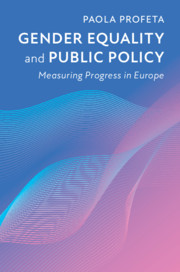Book contents
- Gender Equality and Public Policy
- Gender Equality and Public Policy
- Copyright page
- Contents
- Figures
- Tables
- Preface
- Acknowledgements
- 1 Introduction
- 2 The Scenario
- 3 From Public Policy to Gender Equality
- 4 How Women Affect Public Policy
- 5 How Women Affect Firms’ Outcomes
- 6 Global Challenges, Gender and Public Policy
- 7 Conclusions
- Appendix Useful Methods to Identify the Relationship between Gender and Public Policy
- Bibliography
- Index
4 - How Women Affect Public Policy
Published online by Cambridge University Press: 06 April 2020
- Gender Equality and Public Policy
- Gender Equality and Public Policy
- Copyright page
- Contents
- Figures
- Tables
- Preface
- Acknowledgements
- 1 Introduction
- 2 The Scenario
- 3 From Public Policy to Gender Equality
- 4 How Women Affect Public Policy
- 5 How Women Affect Firms’ Outcomes
- 6 Global Challenges, Gender and Public Policy
- 7 Conclusions
- Appendix Useful Methods to Identify the Relationship between Gender and Public Policy
- Bibliography
- Index
Summary
The chapter answers the following questions: Are female politicians making different decisions than male politicians? Is a gender-balanced composition of policymakers influencing the level of public spending and the allocation among different items? Is it reorienting the priorities of politicians towards, for example, social or welfare expenditures? Before analyzing the relationship between the gender of politicians and public policy outcomes, the chapter provides new evidence that male and female political candidates have different preferences which create expectations for a different political agenda. Both macro evidence and micro evidence are presented to identify the impact of women in decision-making positions on public policy. The chapter shows that, as a general result, the allocation of expenditures, rather than the total size, is responsive to the gender of politicians. Moreover, the results differ between developing and developed countries: in developing countries we observe that, as expected, a higher share of women is associated with policies that are more oriented towards social issues, education and women’s needs, whereas in developed countries, the evidence is much less conclusive. Finally, the chapter provides evidence of the impact of women in decision-making positions on a different dimension of public policy, for example, monetary policy.
- Type
- Chapter
- Information
- Gender Equality and Public PolicyMeasuring Progress in Europe, pp. 58 - 82Publisher: Cambridge University PressPrint publication year: 2020

